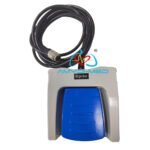Mar. 28 , 2019
This is a very common cause, especially in critically ill patients, when the output is decreased or the peripheral vasoconstriction is severe, the local blood perfusion is reduced, self-evident, which is unreliable in the measurement of the Oximax SpO2 Sensor. In this case, the ear probe is superior to the acromion probe.
For example, in a shock patient, the limbs are cool and cold. At this time, the finger oxygen sleeve of the clip shows that 80% is unreliable. If it is a disposable finger sleeve for ECG monitoring, we should not look at SpO2 first. The specific value, but first look at its signal strength, if the signal is very weak, the SpO2 value obtained in this case is not reliable, or need to be analyzed by arterial blood gas analysis.
One night shift, the nurse rushed to say that the 20-bed GE-Marquette ECG Cable fell to 80%! The first thought I rushed over was to increase the oxygen flow first, but the patient’s breathing, blood pressure, and heart rate were not significantly abnormal. Then the patient’s palm was exposed outside the quilt. In the winter, the fingers were all ice, and the handle was stuffed back. In the bed, SpO2 rose to 96% after 10 minutes.



